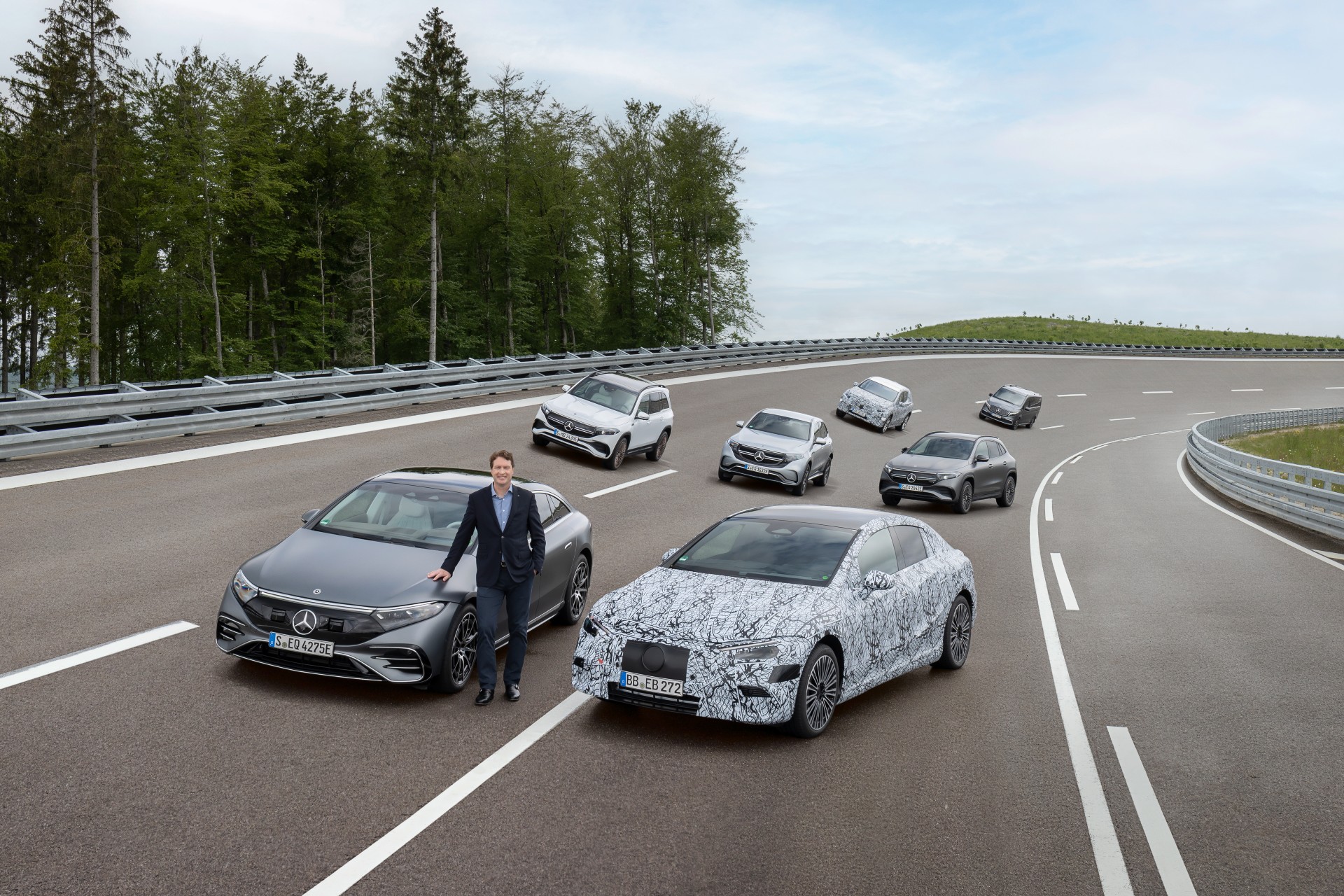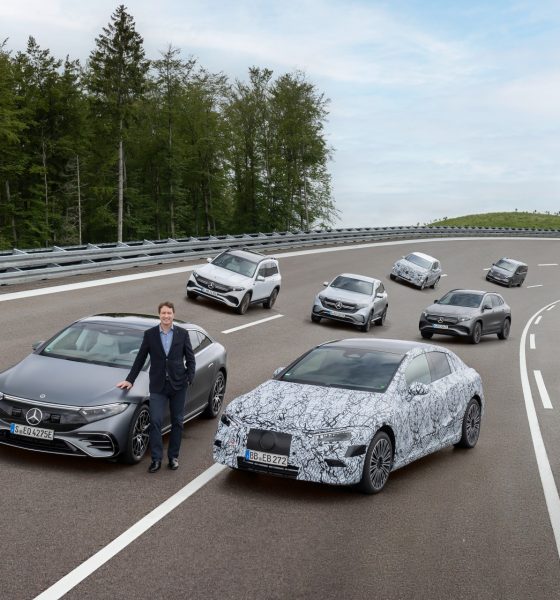Mercedes-Benz is going all-electric starting in 2025, with plans to launch three electric-only architectures that year and install over 200 Gigawatt hours of battery cell capacity across eight factories.
Earlier today, Mercedes-Benz, a German automaker based in Stuttgart, announced its plan to be fully electric by the end of the decade. However, any newly launched architectures will be electric-only starting in 2025, the company said.
“Mercedes-Benz is getting ready to go all-electric by the end of the decade, where market conditions allow. Shifting from electric-first to electric-only, the world’s preeminent luxury car company is accelerating toward an emissions-free and software-driven future,” the company stated in a press release.
Mercedes EQS EV spied benchmarking against Tesla Model S and Model 3
Mercedes-Benz is just one of the many automakers that are now choosing to transition to fully electric lineups. As the dynamic of the automotive industry continues to work toward a transition to electric powertrains, more companies are announcing their plans to ditch combustion engines in favor of battery-powered cars. Lamborghini is one of the more notable car companies that has announced this strategy.
The market shift is most certainly the root cause of Mercedes’ decision to transition to a fully electric lineup in the coming years. “The EV shift is picking up speed – especially in the luxury segment, where Mercedes-Benz belongs,” Daimler AG and Mercedes-Benz AG CEO Ola Källenius said. “The tipping point is getting closer, and we will be ready as markets switch to electric-only by the end of this decade.”
Electric automotive enthusiasts are often skeptical of legacy automakers and OEMs alike, especially when plans or announcements come out that indicate a long-time ICE giant is planning to transition to electrification. There needs to be more than an announcement to convince shareholders and skeptics of their plan. Mercedes has a comprehensive game plan put in place that will solidify its intentions to ditch ICE vehicles, and it starts with a massive investment into battery EVs, which totals over €40 billion ($47.089 billion). The automaker has broken down its plan into four parts: Technology, Production, People, and Financial.
The tech plan includes three new architectures: the MB-EA, the AMG.EA, and the VAN.EA. Each architecture will power a specific class of vehicles, from performance vehicles to medium and large passenger cars to light commercial vehicles.
The production plan outlines how Mercedes plans to transition to BEV manufacturing, including assistance from GROB, a German global leader in highly innovative battery production and automated systems. Mercedes said it also plans to install a new battery recycling factory in Kuppenheim, Germany, which will help develop and secure recycling capacity. This will be operational in 2023.
The people plan outlines the retraining and reskilling of current employees. This has already been started, as Mercedes-Benz said it has already trained about 20,000 employees in aspects of e-mobility.
Finally, the financial plan shows that the company will reallocate its capital from “EV-first” to “EV-only.” Mercedes-Benz writes:
“Investments into combustion engines and plug-in hybrid technologies will drop by 80% between 2019 and 2026. On this basis, Mercedes-Benz projects company margins in a BEV world which are similar to those in the ICE era.”
You can read Mercedes-Benz entire plan here.

News
Tesla FSD fleet is nearing 7 billion total miles, including 2.5 billion city miles
As can be seen on Tesla’s official FSD webpage, vehicles equipped with the system have now navigated over 6.99 billion miles.

Tesla’s Full Self-Driving (Supervised) fleet is closing in on almost 7 billion total miles driven, as per data posted by the company on its official FSD webpage.
These figures hint at the massive scale of data fueling Tesla’s rapid FSD improvements, which have been quite notable as of late.
FSD mileage milestones
As can be seen on Tesla’s official FSD webpage, vehicles equipped with the system have now navigated over 6.99 billion miles. Tesla owner and avid FSD tester Whole Mars Catalog also shared a screenshot indicating that from the nearly 7 billion miles traveled by the FSD fleet, more than 2.5 billion miles were driven inside cities.
City miles are particularly valuable for complex urban scenarios like unprotected turns, pedestrian interactions, and traffic lights. This is also the difference-maker for FSD, as only complex solutions, such as Waymo’s self-driving taxis, operate similarly on inner-city streets. And even then, incidents such as the San Francisco blackouts have proven challenging for sensor-rich vehicles like Waymos.
Tesla’s data edge
Tesla has a number of advantages in the autonomous vehicle sector, one of which is the size of its fleet and the number of vehicles training FSD on real-world roads. Tesla’s nearly 7 billion FSD miles then allow the company to roll out updates that make its vehicles behave like they are being driven by experienced drivers, even if they are operating on their own.
So notable are Tesla’s improvements to FSD that NVIDIA Director of Robotics Jim Fan, after experiencing FSD v14, noted that the system is the first AI that passes what he described as a “Physical Turing Test.”
“Despite knowing exactly how robot learning works, I still find it magical watching the steering wheel turn by itself. First it feels surreal, next it becomes routine. Then, like the smartphone, taking it away actively hurts. This is how humanity gets rewired and glued to god-like technologies,” Fan wrote in a post on X.
News
Tesla starts showing how FSD will change lives in Europe
Local officials tested the system on narrow country roads and were impressed by FSD’s smooth, human-like driving, with some calling the service a game-changer for everyday life in areas that are far from urban centers.

Tesla has launched Europe’s first public shuttle service using Full Self-Driving (Supervised) in the rural Eifelkreis Bitburg-Prüm region of Germany, demonstrating how the technology can restore independence and mobility for people who struggle with limited transport options.
Local officials tested the system on narrow country roads and were impressed by FSD’s smooth, human-like driving, with some calling the service a game-changer for everyday life in areas that are far from urban centers.
Officials see real impact on rural residents
Arzfeld Mayor Johannes Kuhl and District Administrator Andreas Kruppert personally tested the Tesla shuttle service. This allowed them to see just how well FSD navigated winding lanes and rural roads confidently. Kruppert said, “Autonomous driving sounds like science fiction to many, but we simply see here that it works totally well in rural regions too.” Kuhl, for his part, also noted that FSD “feels like a very experienced driver.”
The pilot complements the area’s “Citizen Bus” program, which provides on-demand rides for elderly residents who can no longer drive themselves. Tesla Europe shared a video of a demonstration of the service, highlighting how FSD gives people their freedom back, even in places where public transport is not as prevalent.
What the Ministry for Economic Affairs and Transport says
Rhineland-Palatinate’s Minister Daniela Schmitt supported the project, praising the collaboration that made this “first of its kind in Europe” possible. As per the ministry, the rural rollout for the service shows FSD’s potential beyond major cities, and it delivers tangible benefits like grocery runs, doctor visits, and social connections for isolated residents.
“Reliable and flexible mobility is especially vital in rural areas. With the launch of a shuttle service using self-driving vehicles (FSD supervised) by Tesla in the Eifelkreis Bitburg-Prüm, an innovative pilot project is now getting underway that complements local community bus services. It is the first project of its kind in Europe.
“The result is a real gain for rural mobility: greater accessibility, more flexibility and tangible benefits for everyday life. A strong signal for innovation, cooperation and future-oriented mobility beyond urban centers,” the ministry wrote in a LinkedIn post.
News
Tesla China quietly posts Robotaxi-related job listing
Tesla China is currently seeking a Low Voltage Electrical Engineer to work on circuit board design for the company’s autonomous vehicles.

Tesla has posted a new job listing in Shanghai explicitly tied to its Robotaxi program, fueling speculation that the company is preparing to launch its dedicated autonomous ride-hailing service in China.
As noted in the listing, Tesla China is currently seeking a Low Voltage Electrical Engineer to work on circuit board design for the company’s autonomous vehicles.
Robotaxi-specific role
The listing, which was shared on social media platform X by industry watcher @tslaming, suggested that Tesla China is looking to fill the role urgently. The job listing itself specifically mentions that the person hired for the role will be working on the Low Voltage Hardware team, which would design the circuit boards that would serve as the nervous system of the Robotaxi.
Key tasks for the role, as indicated in the job listing, include collaboration with PCB layout, firmware, mechanical, program management, and validation teams, among other responsibilities. The role is based in Shanghai.
China Robotaxi launch
China represents a massive potential market for robotaxis, with its dense urban centers and supportive policies in select cities. Tesla has limited permission to roll out FSD in the country, though despite this, its vehicles have been hailed as among the best in the market when it comes to autonomous features. So far, at least, it appears that China supports Tesla’s FSD and Robotaxi rollout.
This was hinted at in November, when Tesla brought the Cybercab to the 8th China International Import Expo (CIIE) in Shanghai, marking the first time that the autonomous two-seater was brought to the Asia-Pacific region. The vehicle, despite not having a release date in China, received a significant amount of interest among the event’s attendees.










